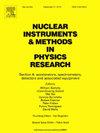OGS/聚苯乙烯闪烁体(BSO-406)与纯OGS (BSO-100)、EJ-276、EJ-309和M600闪烁体的比较
IF 1.5
3区 物理与天体物理
Q3 INSTRUMENTS & INSTRUMENTATION
Nuclear Instruments & Methods in Physics Research Section A-accelerators Spectrometers Detectors and Associated Equipment
Pub Date : 2025-04-22
DOI:10.1016/j.nima.2025.170559
引用次数: 0
摘要
研究了新型BSO-406闪烁体(40%有机玻璃+ 60%聚苯乙烯)的闪烁性能和脉冲形状识别性能。我们测试了一个尺寸为2 × 2英寸的圆柱形样品。这项研究包括测量中子-伽马分辨能力、发射光谱、光电子产率,以及分析与伽马射线和快中子有关的事件产生的光脉冲形状。结果与先前使用纯有机玻璃闪烁体(BSO-100), EJ-309液体闪烁体以及EJ-276和M600聚氨酯塑料闪烁体记录的数据进行了比较。结果表明,虽然BSO-406的光输出比纯OGS低40%,但仍与EJ-309相当,约为13000 ph/MeV。其PSD性能虽然略低于OGS,但在塑料闪烁体中是最好的。本文章由计算机程序翻译,如有差异,请以英文原文为准。
Comparison of an OGS/Polystyrene scintillator (BSO-406) with pure OGS (BSO-100), EJ-276, EJ-309, and M600 scintillators
The scintillation properties and pulse shape discrimination (PSD) performance of the new BSO-406 (40 % organic glass scintillator and 60 % polystyrene) were investigated. We tested a cylindrical sample with dimensions of 2 × 2 inches. The study includes measurements of neutron-gamma discrimination capability, emission spectra, photoelectron yield, and the analysis of light pulse shapes originating from events related to gamma-rays and fast neutrons. The results were compared to data previously recorded using a pure Organic Glass Scintillator (BSO-100), an EJ-309 liquid scintillator, and EJ-276 and M600 polyurethane-based plastic scintillators. The results show that while BSO-406 has a 40 % lower light output compared to pure OGS, it remains comparable to EJ-309, with approximately 13 000 ph/MeV. Its PSD performance, although slightly lower than that of OGS, is the best among plastic scintillators.
求助全文
通过发布文献求助,成功后即可免费获取论文全文。
去求助
来源期刊
CiteScore
3.20
自引率
21.40%
发文量
787
审稿时长
1 months
期刊介绍:
Section A of Nuclear Instruments and Methods in Physics Research publishes papers on design, manufacturing and performance of scientific instruments with an emphasis on large scale facilities. This includes the development of particle accelerators, ion sources, beam transport systems and target arrangements as well as the use of secondary phenomena such as synchrotron radiation and free electron lasers. It also includes all types of instrumentation for the detection and spectrometry of radiations from high energy processes and nuclear decays, as well as instrumentation for experiments at nuclear reactors. Specialized electronics for nuclear and other types of spectrometry as well as computerization of measurements and control systems in this area also find their place in the A section.
Theoretical as well as experimental papers are accepted.

 求助内容:
求助内容: 应助结果提醒方式:
应助结果提醒方式:


